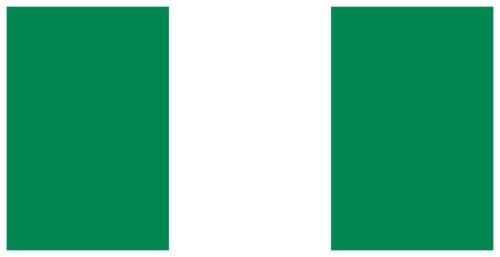
Flag of Nigeria
July
Weather in July
July continues the rainy season across Nigeria, with the intensity of precipitation varying between the northern and southern regions.
In southern cities such as Lagos and Port Harcourt, July sees a slight decrease in rainfall compared to June, though precipitation levels remain high. Daytime temperatures range from 26°C (78.8°F) to 30°C (86°F), while at night, temperatures drop to between 21°C (69.8°F) and 24°C (75.2°F). Despite the slight decrease in rainfall, humidity levels remain high throughout the month.
Contrastingly, the northern regions of Nigeria, including cities like Kano, experience an increase in rainfall in July. The rains provide relief from the high temperatures, with daytime averages falling between 28°C (82.4°F) to 33°C (91.4°F). Night temperatures also cool down, ranging from 20°C (68°F) to 23°C (73.4°F).
When compared to June, July sees a decrease in rainfall in the southern regions and an increase in the northern parts of Nigeria. The temperatures across the country are generally cooler due to the continued rainy season, particularly in the northern regions.
As the country moves into August, the rainy season continues, but with reduced intensity. The southern regions start experiencing a short dry spell, known as the "August break", characterized by a decrease in rainfall. Meanwhile, the northern regions continue to see significant precipitation.
In southern cities such as Lagos and Port Harcourt, July sees a slight decrease in rainfall compared to June, though precipitation levels remain high. Daytime temperatures range from 26°C (78.8°F) to 30°C (86°F), while at night, temperatures drop to between 21°C (69.8°F) and 24°C (75.2°F). Despite the slight decrease in rainfall, humidity levels remain high throughout the month.
Contrastingly, the northern regions of Nigeria, including cities like Kano, experience an increase in rainfall in July. The rains provide relief from the high temperatures, with daytime averages falling between 28°C (82.4°F) to 33°C (91.4°F). Night temperatures also cool down, ranging from 20°C (68°F) to 23°C (73.4°F).
When compared to June, July sees a decrease in rainfall in the southern regions and an increase in the northern parts of Nigeria. The temperatures across the country are generally cooler due to the continued rainy season, particularly in the northern regions.
As the country moves into August, the rainy season continues, but with reduced intensity. The southern regions start experiencing a short dry spell, known as the "August break", characterized by a decrease in rainfall. Meanwhile, the northern regions continue to see significant precipitation.
- Lagos - July »
Coming to the month of July, Lagos experiences a marginal decrease in temperatures. In Lagos, in July, during 13.2 rainfall days, 257mm (10.12") of precipitation is typically accumulated. - Kano - July »
In Kano in July, during 13 rainfall days, 174mm (6.85") of precipitation is typically accumulated. On the first day of July in Kano, sunrise is at 06:05 and sunset at 18:54. - Ibadan - July »
The month with the most rainfall in Ibadan is July, when the rain falls for 20.1 days and typically aggregates up to 76mm (2.99") of precipitation. In Ibadan in July, during 20.1 rainfall days, 76mm (2.99") of precipitation is typically accumulated. - Abuja - July »
On the first day of July sunrise is at 06:15 and sunset at 18:53. In Abuja, in July, during 26.1 rainfall days, 174mm (6.85") of precipitation is typically accumulated. - Port Harcourt - July »
The month with the most rainfall in Port Harcourt is July, when the rain falls for 29.8 days and typically aggregates up to 293mm (11.54") of precipitation. In Port Harcourt, during July, the rain falls for 29.8 days and regularly aggregates up to 293mm (11.54") of precipitation. - Maiduguri - July »
Combine a dip in daily sunlight hours to 12.7 hours with Maiduguri's highest recorded rainfall of 147mm (5.79"), and July emerges as the city's rainiest month. On the last day of July, in Maiduguri, sunrise is at 05:54 and sunset at 18:33 WAT. - Zaria - July »
January, July, August, November and December, with an average maximum UV index of 6, are months with the lowest UV index in Zaria, Nigeria. On the first day of July in Zaria sunrise is at 06:10 and sunset at 18:56. - Jos - July »
The month with the most rainfall in Jos is July, when the rain falls for 30.5 days and typically aggregates up to 284mm (11.18") of precipitation. The month with the most rainfall is July, when the rain falls for 30.5 days and typically aggregates up to 284mm (11.18") of precipitation. - Oyo - July »
In July, the average heat index, which combines relative humidity and air temperature, is appraised at 36°C (96.8°F). July brings a slight dip in temperature, rainfall, and cloud cover compared to June. - Enugu - July »
July, like June, is another hot summer month in Enugu with temperature in the range of an average high of 30°C (86°F) and an average low of 22°C (71.6°F). July through September, with an average high-temperature of 30°C (86°F), are marked as the coldest months in Enugu, Nigeria.
Updated: May 24, 2024
Published by: Weather Atlas | About Us
Data Sources | Weather Forecasting & Climate
Published by: Weather Atlas | About Us
Data Sources | Weather Forecasting & Climate


